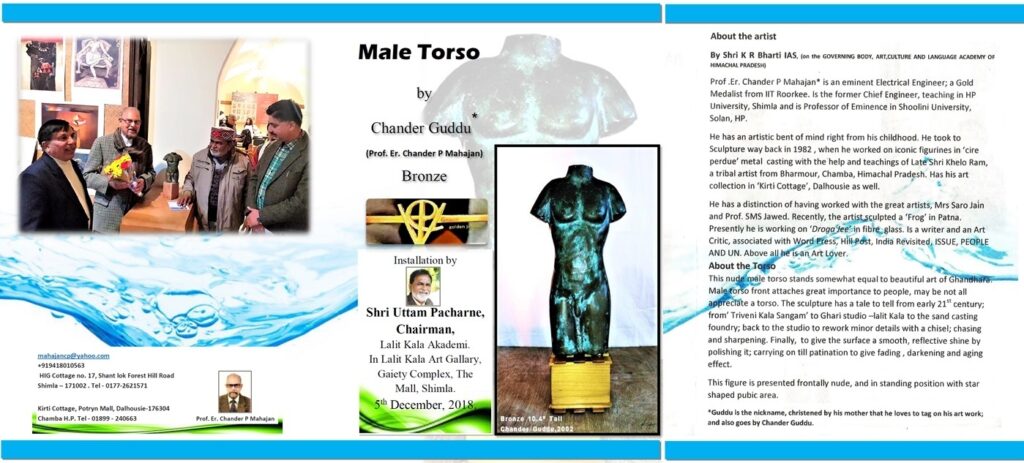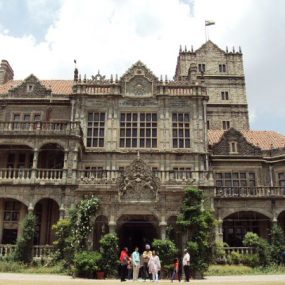I happened to meet Shri Uttam Pacharne, Chairman, of Lalit Kala Akademi, while he was in Shimla to head the exhibition of the artworks Created during the painting camp held from 29 November to 5 December 2016 at Lalit Kala Akademi, Craig Garden Shimla.
I was extended a warm welcome at Craig Garden where the artists received me with open arms; & thereafter at the Gaiety Complex where Sh. Pacharne had cordially invited me to exhibit my creation in bronze at the historic event. I gladly exhibited the male torso; which goes by as my ‘masterpiece.’
To my pleasant surprise, my work was admired and I was bestowed with immense honour by one and all.
- The torso is a general region of the body, making up the area from the shoulders down to the hips. It is the center of the body without the head, arms, and legs, but would include the chest and abdominal area.
By and large, torso length is the vertical distance between the highest point on the shoulders and the natural waistline; also, there is a correlation between a person’s height and their torso length. Some of us have large torsos and short legs, and some short torsos and long legs. The average Straight-Line Torso length for males is 18″ to 20.5″.
A torso is thus the trunk of a human body — minus arms, legs, and head. A statue of a torso in a museum, usually ancient Greek or Roman, is that of the trunk of a human body.
- Carved in red jasper stone, the statuette of a nude male torso with a missing head, arms, and legs was excavated in Harappa (Indus Valley Civilisation). It has socket holes in the neck and shoulders for the attachment of the head and arms. The shoulders are well carved and the abdomen looks slightly prominent.
These works of art are so old that they’ve frequently lost their arms and heads, but still, the sturdy torso remains.
The male torso front attaches great importance to people; maybe not all appreciate a torso.
- Guddu’s ‘Male Torso ‘has a tale to tell from the early 21st century. From Triveni Kala Sangam to Garhi Studio- Lalit Kala Academy on to the sand casting foundry. Back to the studio to rework minor details with a chisel, chasing and sharpening; and then to give the surface a smooth, reflective shine by polishing it; carrying on till patination to give fading, darkening, and aging effects. The figure is presented frontally nude, and in a standing position with a star-shaped pubic area.
Inspired; in Feb 2002, during the days of my modeling in clay in Madam Saro Jain’s studio, I conceived the idea of creating a male torso. Female artists around; Mrs. Madhulika Jha being senior; shared many ideas. The other one suggested that I better gaze at myself in to mirror to get the right perception of my prospective model. That is how I tried my torso.
Perhaps, the perfect body size was not the bigger and muscular as found in bodybuilders but rather a lean and slightly lower muscle mass was what attracted women. Women prefer men whose torso has an ‘inverted triangle’ shape (i.e. a narrow waist and a broad chest and shoulders). When women look at men’s torsos, the V shape is victorious.
“When women judge a man’s physical attractiveness, lower-body shape plays a negligible role.”
Leanness rules over hugeness. The right lean body shape is the dream of any man.
Someone proposed Garhi Studio, for turning clay into bronze; where I met Jawed by chance, who showed me his studio No. 5; and I liked working. A plaster of Paris mould of the clay followed by sand casting and machining in the vicinity, did the bronze.
The Torso lived for many years in Japan, with my son, Aseem Mahajan, who once narrated to me a joke cracked by a customs official about its all-in-one organ.
The last I visited Lalit Kala Akademi, Shimla, was to find the torso in utter neglect. To my dismay, it is no more on display as an exhibit in the Arts gallery; rather dumped on the sill of an office window in a corner, showing blatant disregard for the piece of art. Even the accompanying visitor’s book is taken away. I wonder if I am compelled to withdraw it from the premises of the Akademi.
………………………………………………………………………………………………………..
https://hillpost.in/2017/10/109622/109622/
https://www.youtube.com/watch?v=o_U1WiVfMVI
https://en.wikipedia.org/wiki/Indus_Valley_Civilisation
Prof. (Er.) Chander P Mahajan is an art critic & a free lance journalist. The Environmentalist stays in Shimla and Dalhousie, Himachal Pradesh, India.









